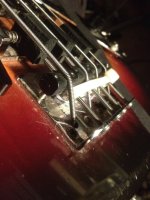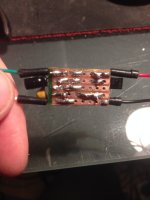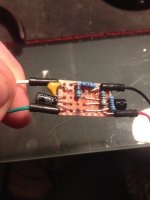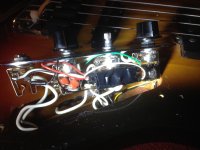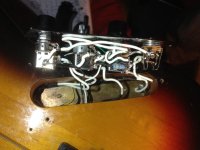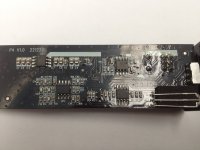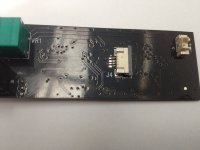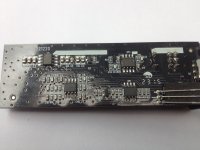As you can see, space is fairly limited since I am running a somewhat unconventional wiring in my fretless Jazz.
It's VBT with phase reverse switch, alternative cap switch (for quasi series sound) and the DPDT MN50K blend switches between the passive magnetics and the buffered Graphtech piezo ghost saddles.
Yes, I already have a buffer in my bass but it doesn't have any gain and as you can see I need serious tactics to get the control plate closed as it is. Nothing bigger would fit.
The 9V for the buffer is supplied via TRS cable. When not in Piezo mode, the ring outputs the passive unbuffered piezo signal, making the bass stereo output (regular magnetic on tip).
I know it might seem stupid to not just connect the magnetics to the buffer or install an alternative internal preamp but the thing is, either way I need the Rockboard itself to provide more gain, since I also need it for vocal monitoring and there the signal is even weaker.
Also, I like the safety backup of not having to rely on any sort of power supply to get a functional output from the bass.
Will post pictures of the Rockboard PCB tomorrow with daylight.
It's VBT with phase reverse switch, alternative cap switch (for quasi series sound) and the DPDT MN50K blend switches between the passive magnetics and the buffered Graphtech piezo ghost saddles.
Yes, I already have a buffer in my bass but it doesn't have any gain and as you can see I need serious tactics to get the control plate closed as it is. Nothing bigger would fit.
The 9V for the buffer is supplied via TRS cable. When not in Piezo mode, the ring outputs the passive unbuffered piezo signal, making the bass stereo output (regular magnetic on tip).
I know it might seem stupid to not just connect the magnetics to the buffer or install an alternative internal preamp but the thing is, either way I need the Rockboard itself to provide more gain, since I also need it for vocal monitoring and there the signal is even weaker.
Also, I like the safety backup of not having to rely on any sort of power supply to get a functional output from the bass.
Will post pictures of the Rockboard PCB tomorrow with daylight.
Attachments
I need the Rockboard itself to provide more gain, since I also need it for vocal monitoring and there the signal is even weaker.
Does that mean that you need an input that works well with an electric guitar as the signal source, and also with a microphone as the signal source?
No, just a simple mono instrument input.
I am not using the XLR input of the Rockboard since it has even less gain.
I connect the mic with an impedance transformer (Shure A85F), making it instrument level.
I am not using the XLR input of the Rockboard since it has even less gain.
I connect the mic with an impedance transformer (Shure A85F), making it instrument level.
Maybe...
Although you say its a 3 volt amp I see what looks like an LM2662 chip which is like a DC/DC convertor (its actually a capacitor charge pump type convertor) and can generate -/+5 volt rails from 3 volts. Also I think I can make out a 4558 opamp which again suggests -/+5v rails might be present. You could maybe measure that on pins 4 and 8 of the opamp.
If the 4558 is an input stage then altering the gain might be possible. I can't make out the numbers of the other chips though. Opamp circuitry is certainly alterable in gain and typically just by a resistor change.
You would have to see where the input signal is fed into as a starting point.
Although you say its a 3 volt amp I see what looks like an LM2662 chip which is like a DC/DC convertor (its actually a capacitor charge pump type convertor) and can generate -/+5 volt rails from 3 volts. Also I think I can make out a 4558 opamp which again suggests -/+5v rails might be present. You could maybe measure that on pins 4 and 8 of the opamp.
If the 4558 is an input stage then altering the gain might be possible. I can't make out the numbers of the other chips though. Opamp circuitry is certainly alterable in gain and typically just by a resistor change.
You would have to see where the input signal is fed into as a starting point.
Then you ALREADY have 9V inside your Bass! 🙄the buffered Graphtech piezo ghost saddles.
Yes, I already have a buffer in my bass but it doesn't have any gain and as you can see I need serious tactics to get the control plate closed as it is. Nothing bigger would fit.
The 9V for the buffer is supplied via TRS cable. When not in Piezo mode, the ring outputs the passive unbuffered piezo signal, making the bass stereo output (regular magnetic on tip).
What are we talking/worrying about then? 😄
And you already have a stamp sized perf board inside. 😲
Actually two stamps worth counting bent out components.
You can very well design a same size board using an SMD dual Op Amp with two side by side gain stages, one unity gain for Piezo pickup, the other with 12dB gain.
Easy peasy, no need for "special" 3V rail to rail Op Amps.
Board will actually be flatter than current one, you can wrap it in baking paper or similar for insulation.
Think about it.
You can order 5 or 10 from China for peanuts, "already populated" , so you just solder it in place.
It's not really possible to see where the input goes after the bus connector on the backside.
In the meantime here is a pic that shows the writing better.
The OP1662 is an extremely high performance opamp, so much so that it is surprising to see a 4558 in there as well (the 4558 is a generic type common device of OK performance).
I think the other chip might be an LM4808 which is a small power amp (100mw or so) so that fits as a headphone driver. The gain of that looks alterable. Altering the opamp gain would need us to know more of the circuit details I'm afraid such as what opamp does what and how they are configured.
May be you can look into TI OPA 358 opamp.
Single supply 2.7 to 3.3 volts, can use in media players (Yes video, I know).
Regards.
Single supply 2.7 to 3.3 volts, can use in media players (Yes video, I know).
Regards.
The OPA358 is very noisy at audio frequencies - its for video, not audio and has a very high 1/f knee. (and don't even consider the LM358!)
AA batteries can be 2000mAh, so 5mA a channel translates to 200 hour battery life - not so difficult. The AD8656 will work at 2.7V, is rail-to-rail and 3.7mA per amp, 0.0007% THD+N at 2.7V supply, can sort of drive headphones directly (+/-75mA output current)
AA batteries can be 2000mAh, so 5mA a channel translates to 200 hour battery life - not so difficult. The AD8656 will work at 2.7V, is rail-to-rail and 3.7mA per amp, 0.0007% THD+N at 2.7V supply, can sort of drive headphones directly (+/-75mA output current)
- Home
- Live Sound
- Instruments and Amps
- Extremely simple 3V instrument preamp suggestions?
